LASEK innovator gives epi-LASIK high marks
Advantages include the quality of the flap and the procedure’s efficacy in eyes with tightly adherent epithelium, surgeon says.
ROME – Epi-LASIK is a useful innovation of laser epithelial keratomileusis, according to Massimo Camellin, MD, who developed the LASEK procedure in 1998.
Dr. Camellin recently started using the Centurion SES epikeratome from Norwood EyeCare in selected patients. Contrary to his expectations, he said, he found that the mechanical separation of the epithelium works better than alcohol in eyes in which the epithelium is tightly adherent to the stroma.
“At first I thought that epi-LASIK might be a good idea in fairly easy conditions in my own patients, while tight epithelia might resist the mechanical action of the instrument and would be better treated with alcohol separation,” Dr. Camellin said. “Direct experience made me change my mind, and I was happy to discover in my own patients that the instrument cuts the flap easily and smoothly independent of how much the epithelium is attached to the stroma.”
The epikeratome makes flap performance easier in all cases, shortening the learning curve of LASEK, he said.
Dr. Camellin described his experience with the epi-LASIK procedure at the ESCRS Winter Refractive Surgery Meeting.
Better flaps, comparable results
Dr. Camellin noted that the epithelial flaps have a better appearance when performed with the epikeratome. He said the flaps are more integral, smoother and more viable.
In a study, he is now comparing the results of the two techniques, performing epi-LASIK in one eye and LASEK in the fellow eye of selected patients.
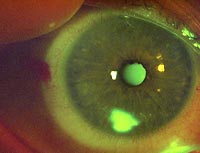 |
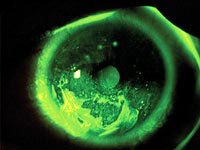 Epi-LASIK (top) and LASEK (bottom) eyes 3 days after the removal of the bandage contact lens. The epi-LASIK flap is smooth and viable. The LASEK flap has disintegrated and a new epithelium is growing. Images: Camellin M. |
“In the eight patients I have operated on so far, all epi-LASIK flaps were just perfect, even when alcohol separation in the fellow eye was difficult and resulted in a poor quality flap,” he said.
Postoperative visual acuity results and recovery time have not shown substantial differences, he said.
“Postoperative uncorrected visual acuity was comparable or better in the LASEK eye in some of the patients and in the epi-LASIK eye in other patients. With both techniques, recovery time ranged between 3 days and 15 days to regain about 80% of preoperative best corrected visual acuity,” Dr. Camellin said.
A slight difference in favor of LASEK was found in the subjective perception of postoperative discomfort. No patient reported pain, but more discomfort was perceived in the epi-LASIK eyes, he said.
“The number of patients I treated is too small to jump to conclusions, but it might be possible that suction increases postoperative discomfort, or maybe alcohol reduces it,” he said.
The study will eventually include a total of 80 patients with a minimum follow-up of 6 months and will evaluate the effects of mechanical vs. alcohol separation in the long-term healing of the epithelium. Haze will be one of the chief parameters, Dr. Camellin said.
“This comparison will give me the opportunity to study the effects of alcohol on the stroma, which could be negative or, paradoxically, even positive,” he said.
Techniques complementary
When asked if he will now convert all of his LASEK procedures into epi-LASIK, Dr. Camellin said that in most cases he will employ the mechanical cutting of the flap, but he will still use alcohol in some patients.
“I believe the two techniques can be quite complementary. In patients with retinal problems, for example, suction is better avoided, and LASEK with alcohol is definitely safer. Also in re-treatment cases, LASEK is a much better option because the flap is irregularly attached to the stroma, and the tight hold at some points would slow the keratome’s progression,” he said.
Dr. Camellin said the lower cost of LASEK could be a reason for choosing that technique in some cases. In highly myopic eyes, in which flap integrity is crucial, the choice should always be in favor of the extra safety provided by mechanical separation, he said, but in the lower myopic range, where the risk is minimal, cost might be a criterion of choice.
“However, the superior quality of epi-LASIK flaps is a definite advantage of the technique, which is on the whole a very positive innovation,” Dr. Camellin said.
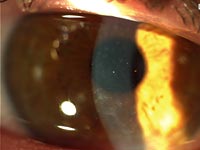 |
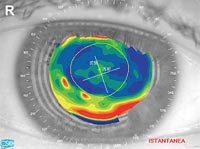 |
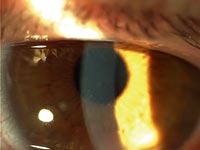 |
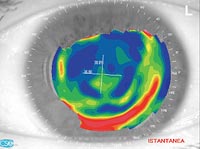 |
| In another patient with epi-LASIK in one eye (left) and LASEK in the other, 3 days after bandage contact lens removal, the corneal surface and epithelium are similar in each eye. | |
Converting to epi-LASIK, he said, will be easy for all LASEK surgeons, but less so for LASIK surgeons. Those surgeons should be aware that dealing with an epithelial rather than a stromal flap is an entirely different matter.
Epithelial flaps are delicate, thin and elastic, and they need completely different management, he said.
Future on the surface
Dr. Camellin said that the Centurion epikeratome is an excellent instrument for safety and predictability, and he is inclined to think that its blunt plastic plate is safe.
“The plate runs very smoothly between epithelium and stroma, causing absolutely no damage to the stromal tissue,” Dr. Camellin said.
The device is also easy and quick to assemble.
“Epi-LASIK is a further step forward in the optimization of surface photoablation procedures, which are the future of refractive surgery,” he said. “They produce a cornea with better optical quality, with none of the risks connected with the stromal flap.”
For Your Information:
- Massimo Camellin, MD, can be reached at Via Dunant 10, 45100 Rovigo, Italy; phone/fax: +39-0425-411357; e-mail cammas@tin.it. Dr. Camellin has no direct financial interest in the products mentioned in this article, nor is he a paid consultant for any companies mentioned.
- Norwood Eyecare, distributor of the Centurion SES Epikeratome with EpiEdge, can be reached at 63 Wells Road, Chelsea Heights, Victoria, 3196 Australia; +61-3-9782-7333; Web site: www.norwoodeyecare.com.
- Michela Cimberle is an OSN Correspondent based in Treviso, Italy.
